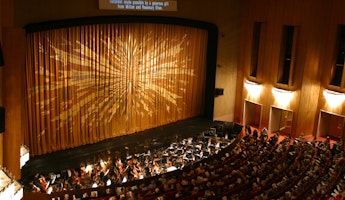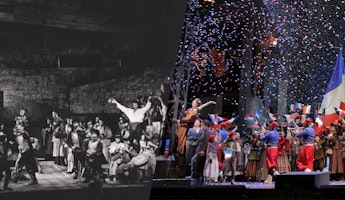Blog
October 25, 2022
Behind the Magic of "Omar": Choreography
Dancing is an artform that helps to tell a story. The way dancers move to the different rhythms using their arms and legs while contorting their bodies to illustrate words and pictures without having to say a word truly shows the power of this artform. Dance plays a supporting role in countless operas, but Omar shows just how important that role can be. For those of you who haven’t seen Omar, it’s based on the autobiography of Omar Ibn Said, a Muslim scholar who was captured in Senegal and enslaved in Charleston, South Carolina. In Act Two, scene two, Omar is taken to a new plantation, where he encounters enslaved workers having an old-fashioned jubilee with dancing and singing. The choreography in this scene seems to blend diasporic African movements with modern day dance that is embedded in Black American culture. According to Kiara Benn, the choreographer of Omar, the movements are inspired by a plethora of Black dance languages that help tell Omar’s story.
“A lot of this process asks dancers to bring themselves to it,” said Benn, “so yes, I'm choreographing it but I'm also creating and holding the structure for people to tell their own dance languages. A lot of the ways we want to tell the story is bringing yourself to the table so having them [dancers] ask themselves ‘how would you tell your story today and how we would tell Omar’s story?’ By bringing ourselves and our unique experiences and backgrounds, we are highlighting and celebrating the movement that is ingrained in our bodies,” said Benn with a twinkle in her eye.
Aside from this production being the first of its kind in sharing its unique historical slavery narrative, it is also meaningful to all the numerous people of color involved who have the freedom to control the narrative and how the story is being told. “A lot of people don't know this story and there are so many stories that people do not know that really center and show how much knowledge and how many contributions we bring to America itself,” echoes Benn. “The fact that there is space being made for this story in the opera world is so important. That is how I also feel while including dance in this story: it creates a lot of entry points for people to enter worlds where they may not feel like they see themselves but the fact that there are so many people of color on stage and so many ways that we are celebrating the histories that allowed us to be and see and do what we want too today is extremely important.”
Although she uses her creativity and artistic direction through choreography, Benn says her role of choreographer is a title but it's also something that allows her to create communities within the production and allows people to see how much value our bodies and minds and interactions hold.








/03-cosi/_dsc0996_pr.jpg?format=auto&fit=crop&w=345&h=200&auto=format)

















